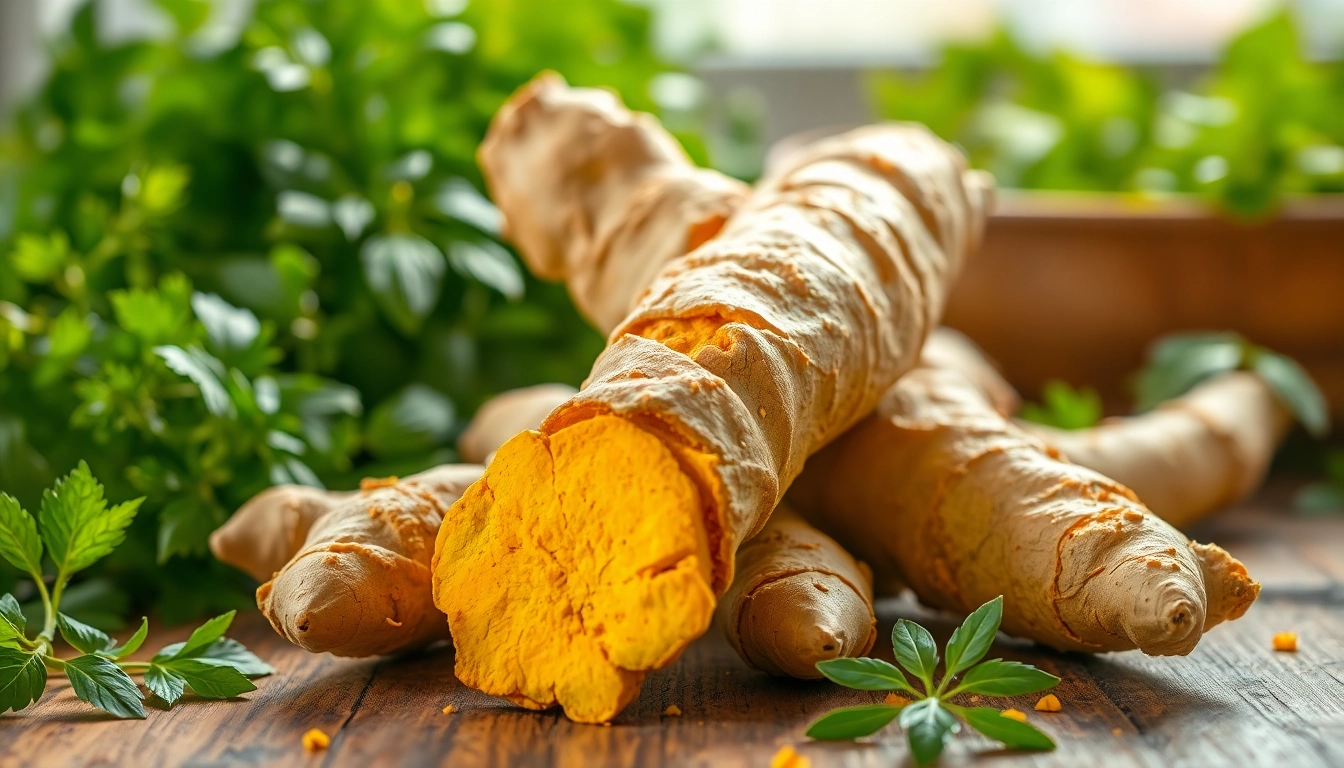Understanding Turmeric Root
What is Turmeric Root?
Turmeric root, scientifically known as Curcuma longa, is a flowering plant belonging to the ginger family. Native to Southeast Asia, it is primarily cultivated in India and other tropical regions for its rhizome—the underground stem that is harvested for its vibrant yellow pigment and potent medicinal properties. The rhizome of turmeric is used extensively in cooking, especially in Asian cuisine, and has garnered recognition for its myriad health benefits. It is commonly powdered and used as a spice, while fresh turmeric root is celebrated for its fundamental role in traditional culinary practices. The popularity of turmeric root has surged in recent years, not just for its flavor but for its recognized health benefits. [Explore our selection of high-quality Turmeric Root products to enrich your diet.]
History and Cultural Significance
The roots of turmeric have been a cornerstone of traditional medicine and culinary practices for thousands of years, dating back to ancient India where it was first cultivated. It has long been a key ingredient in Ayurvedic medicine, recognized for its anti-inflammatory and antioxidant properties. Not only is turmeric sacred in cultural rituals, particularly in Hindu weddings and religious ceremonies, but it has also been utilized to treat various ailments. Beyond its economic importance, turmeric has cemented its place in the cultural identity of many Asian societies, embodying both a culinary and medicinal heritage.
How Turmeric Root is Grown and Harvested
Turmeric thrives in warm, humid climates with well-drained soil. Growers typically plant turmeric rhizomes during the rainy season, allowing the plants to absorb the moisture needed for robust growth. Once planted, the rhizomes take about 7 to 10 months to mature. Farmers harvest the mature turmeric roots by uprooting the plants and washing the rhizomes to remove the soil. After harvesting, turmeric can be processed, either by boiling and drying it or grinding it directly into powder for various uses. This labor-intensive process contributes to the unique profile and quality of turmeric root, making it a valuable agricultural product.
Nutritional Profile of Turmeric Root
Vitamins and Minerals in Turmeric Root
Turmeric root is a treasure trove of nutrients. It contains vitamins such as vitamin C, vitamin B6, and vitamin E, along with essential minerals like manganese, iron, and potassium. The nutrient density varies between fresh and dried forms, with fresh turmeric root providing a wider array of nutrients. The presence of dietary fiber in turmeric also plays a key role in digestive health, contributing to a balanced diet.
The Importance of Curcumin
Curcumin, the primary active compound in turmeric, is responsible for many of its health benefits. This polyphenol is noted for its anti-inflammatory and antioxidant properties, which may support the body in combating disease and promoting overall health. Research has consistently shown that curcumin can potentially reduce the risk of chronic diseases such as heart disease, diabetes, and even cancer, making it integral not only to the health benefits of turmeric root but also to its appeal in dietary supplementation.
Comparative Analysis with Other Roots
When compared to other root vegetables, turmeric stands out due to its unique bioactive compounds, particularly curcumin. While ginger, another member of the Zingiberaceae family, offers anti-nausea and anti-inflammatory benefits, turmeric is significantly more potent in terms of inflammation reduction. Root vegetables such as garlic and onion also provide health benefits, primarily through their sulfur compounds, yet these do not match the specific and profound effects associated with turmeric. Overall, turmeric root is often regarded as one of the most beneficial roots in the realm of health and nutrition.
Health Benefits of Turmeric Root
Anti-Inflammatory Properties
Turmeric is perhaps best known for its powerful anti-inflammatory properties. Chronic inflammation is a key contributor to various diseases, including heart disease and arthritis. Curcumin found in turmeric significantly reduces inflammation at the molecular level by inhibiting multiple inflammatory markers in the body. Numerous studies have indicated that consuming turmeric or curcumin can alleviate symptoms of inflammatory conditions like rheumatoid arthritis, osteoarthritis, and even inflammatory bowel diseases.
Antioxidant Benefits
Another remarkable benefit of turmeric is its high antioxidant content. Curcumin exerts a profound antioxidant effect, which helps to neutralize free radicals and reduce oxidative stress. This function supports healthy aging by protecting cells from damage. Additionally, curcumin enhances the activity of the body’s own antioxidant enzymes, leading to improved overall antioxidant capacity, which can significantly influence health and longevity.
Potential Role in Chronic Disease Management
Research continues to explore turmeric’s potential in chronic disease management. Clinical trials have suggested that turmeric may have therapeutic effects for conditions such as diabetes, cardiovascular diseases, and even cancer. For diabetic patients, curcumin can help regulate insulin sensitivity and reduce sugar levels in the blood. In heart health, its anti-inflammatory nature helps prevent heart disease by reducing cholesterol levels. Furthermore, recent studies point toward its potential role in inhibiting cancer cell growth and metastasis, often presenting turmeric as a promising complement to traditional therapies.
Culinary Applications of Turmeric Root
How to Prepare and Cook with Turmeric Root
Cooking with turmeric root is versatile and adds a unique flavor to a variety of dishes. Fresh turmeric can be grated into smoothies, soups, or stir-fries. It can also be steeped in boiling water to make a soothing tea. When using dried turmeric powder, it is essential to pair it with black pepper, which contains piperine, a compound that enhances the absorption of curcumin significantly. A rule of thumb is to use a 1:10 ratio of turmeric to black pepper for optimized health benefits.
Popular Recipes Featuring Turmeric Root
Incorporating turmeric root into daily meal preparation can be both delicious and nutritious. Here are three popular recipes:
- Golden Milk: A comforting drink made by warming milk (or non-dairy alternative) with turmeric, black pepper, coconut oil, and honey.
- Turmeric Rice: Infuse cooked rice with sautéed turmeric root, onions, and garlic for a flavorful side dish.
- Curried Lentils: Cook lentils with chopped turmeric, ginger, garlic, and an array of spices for a hearty and healthful vegetarian meal.
Pairing Turmeric Root with Other Ingredients
Turmeric root pairs wonderfully with various ingredients, enhancing not only flavor but also health benefits. When cooked with fats like olive oil or coconut oil, the absorption of curcumin is increased, offering enhanced health outcomes. Common pairings include:
- Ginger: Both anti-inflammatory; together they create a potent health tonic.
- Cinnamon: Both spices can synergistically enhance metabolic health.
- Greens: Adding turmeric to leafy greens like spinach or kale can increase their antioxidant properties.
Buying and Storing Turmeric Root
How to Choose Fresh Turmeric Root
Choosing fresh turmeric root involves looking for firm, smooth, and wrinkle-free rhizomes. They should have a vibrant orange-yellow color, indicating high curcumin levels. Avoid roots that appear dried out or have spots, as this can signify spoilage. If opting for turmeric powder, it’s crucial to look for organic options to ensure the absence of harmful additives.
Storage Tips for Longevity
To maximize freshness, store whole turmeric roots in a cool, dark place. They can last for several weeks if kept dry. For longer storage, consider wrapping them in paper towel and placing them in the refrigerator. Dried turmeric powder, on the other hand, should be kept in an airtight container in a cool area away from sunlight, as this prevents degradation and loss of potency.
Where to Buy Quality Turmeric Root
High-quality turmeric root can be purchased at local farmers’ markets, health food stores, and various online retailers that specialize in organic produce. Ensure that the seller provides adequate information about the sourcing and quality of the product. Many health-focused websites also list reputable suppliers where consumers can find authentic turmeric root at competitive prices.



